Over the past five decades, Kee Heung-sung has produced countless miniature models of architecture – both ancient and modern, from East and West. But the crowning glory of his peerless endeavor is his exquisite replicas of traditional Korean structures.
The Kee Heung Sung Museum, located in Yangpyeong, Gyeonggi Province, about an hour’s drive from Seoul, is an intriguing miniature world. Its creator and director, Kee Heungsung, showed a talent for drawing and making things from an early age. His father wanted him to work in civil engineering, saying there would be a surge of public works if the two Koreas were reunited.
Kee was born in 1938 in Ongjin, Hwanghae Province, which is now part of North Korea. His family came down to the South shortly after the Korean War broke out in June 1950. His model-making career dates back to 1967 when, as a rookie architectural designer, he grabbed the attention of Kim Swoo-geun, (1931-1986), a pioneering modern architect and then senior vice president of Korea Engineering Consultants Corp. The company was commissioned to build the grounds for a trade fair. Kee made models with scrap material in his office. When Kim saw them, he exclaimed, “Where did this demon come from?”
That was the moment Kee’s long and successful career took off.
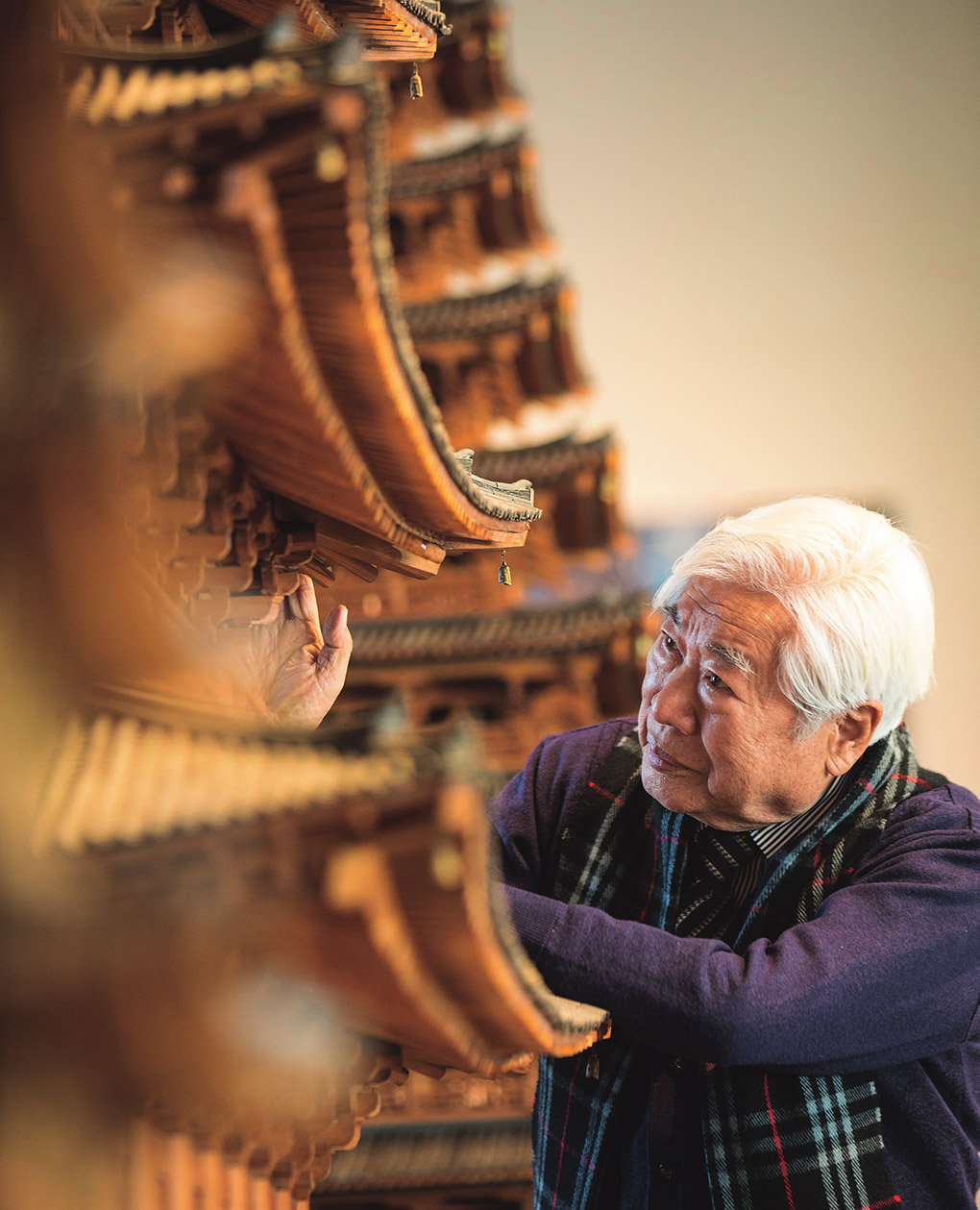
Kee Heung-sung looks at a miniature model of the nine-story wooden pagoda of Hwangnyong Temple, which was the largest Buddhist temple of the Silla Kingdom (57 B.C.-A.D. 935). When building models of ancient structures, he does not use nails but follows traditional dovetail joinery techniques.
Unmatched Talent
His hand was deft and precise. He would be finishing a model when others were still making sketches. And so, having gained Kim’s absolute trust, Kee was promoted to team manager at age 31. In the 1970s, in the midst of the country’s rapid industrialization, he built almost all the presentation models used for national development projects. In a sense, his work bore witness to the history of Korea’s economic development.
“Back then, I was like a relief pitcher at briefings for the president. Drawings have certain limitations in explaining buildings. My models made it far easier to understand the design,” said Kee.
He worked on a continuous series of government projects, including the construction of the Gyeongbu (Seoul-Busan) Expressway and development of Yeouido, an island on the Han River that is home to the National Assembly. He worked hard day and night, taking quick naps on a cot in his office.
The skills Kee had polished in creating miniature models of modern architecture came into their own when he tackled historic buildings. The turning point came when the National Museum of Korea asked him to make a miniature replica of the legendary nine-story wooden pagoda of Hwangnyong Temple, built in the seventh century during the Silla Kingdom. This had been Silla’s largest Buddhist temple, founded to pray for the Buddha’s protection of the country, but it was destroyed by a fire in 1238 during the Mongol invasions. Kee created a fourmeter-high model of the pagoda, which was known to have stood some 80 meters tall overlooking Gyeongju, based solely on historical records.
Recalling that time, he said, “It was back in the 1980s. I spent three years making drawings of the presumed structure, consulting scholars and experts in related fields, including architects, archaeologists and art historians. Then it took another five years to build the actual model.”
Having to reproduce a long-lost ancient pagoda based on informed guesswork made this Kee’s “hardest but most memorable project.” In the exhibition hall on his museum’s basement floor is another replica of the same wooden pagoda, built for “Korean Architectural Culture: Kee Heung-sung’s World of Models,” a special exhibition that celebrated the relocation of the National Folk Museum of Korea in 1993. Kee was lauded at home and abroad for reviving the architectural glory of Silla.
A miniature model of an ancient town at the Lotte World Folk Museum in Seoul has also earned him international recognition. The gorgeous exhibit, built on a scale of 1:8 and covering an area of 1,200 square meters, recreates a vibrant town with various traditional structures, including Gyeongbokgung, the primary palace of the Joseon Dynasty; public schools (hyanggyo) and Buddhist temples; as well as hundreds of miniature people in colorful costumes.
Providing a glimpse of the architecture and lifestyle of premodern Korea, the display is a must-see for visiting foreign dignitaries. On his visit in 2002, Lu Xiaobo, dean of the Academy of Arts and Design at Tsinghua University, expressed his wishes to introduce to China “these wonderful skills that bring to life the beauty of traditional architecture.”
Kee spent two years building the miniature town, painting dancheong (traditional multicolored paintwork) on the wooden structures and baking tiny roof tiles the size of a fingernail. “I almost killed myself,” said Kee. He toiled through the project wearing a pacemaker.
“Lines are crucial in ancient Korean architecture. The curves of upturned eaves are a subtle deviation from a straight line, made with intuition,” Kee said. “Whenever I work on old buildings, I marvel at the wisdom of our ancestors. They have an elegance that can’t be matched by modern architecture. Traditional buildings are so much harder to replicate that at least five years’ experience is necessary for any novice model maker.”
In 2004, Kee served as visiting professor at Tsinghua University’s Academy of Arts and Design to share his knowhow and craftsmanship for the 2008 Beijing Olympics and the Expo 2010 Shanghai.
China Central Television covered “Kee Heung-sung’s World of Models,” the exhibition held in Beijing in June 2004, in a special program.
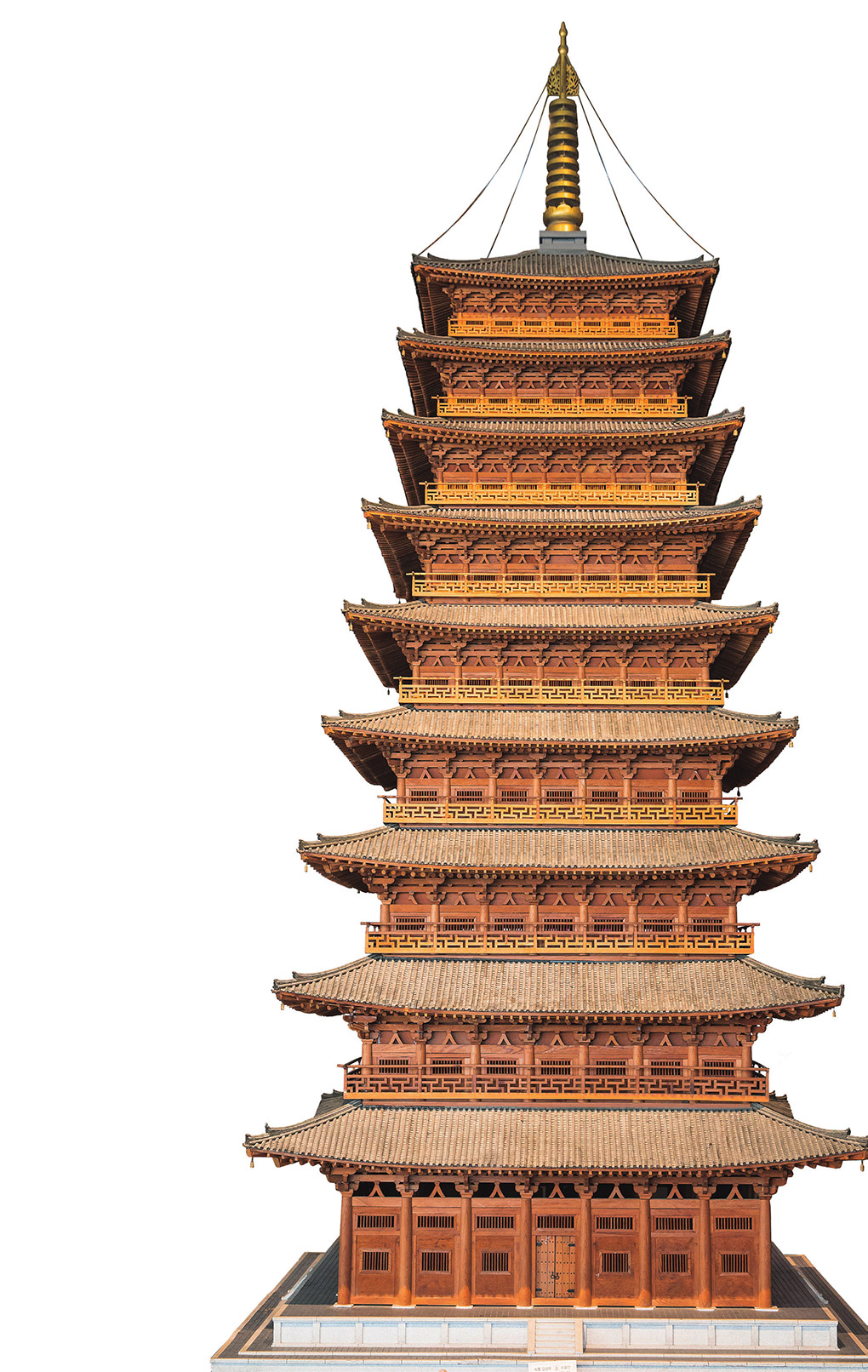
Known to have stood 80 meters high, the seventh-century wooden pagoda of Hwangnyong Temple has been restored in a 1:20 scale model. Kee spent three years conducting research on the long-lost pagoda and making drawings of the presumed structure, then another five years on building the model.
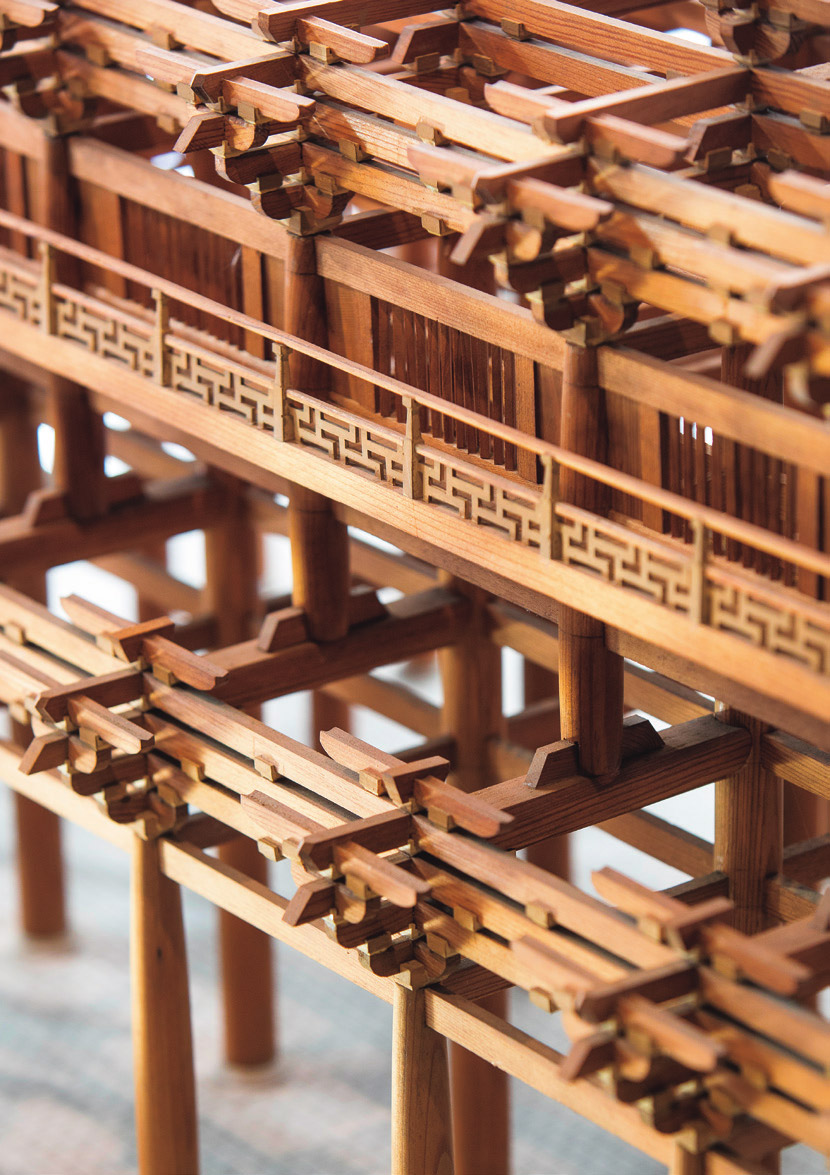
The balustrade along the wraparound balcony of each floor features intricate geometric latticework. The pagoda was burned down along with the entire temple during the Mongol invasions in the 13th century.
“A mere copy of the external features will not impress the viewer. A model should be both precise and beautiful.”
Museum for a Lifetime’s Work
The Kee Heung Sung Museum opened in 2016, marking the 50th anniversary of his career. The result of a long-cherished dream to showcase his works and share his knowledge and knowhow, the museum exhibits more than 1,000 models. The basement level houses the Hall of Traditional Korean Architecture, where Sungnyemun, the old south gate of Seoul, stands at the entrance, a testament to what this national treasure looked like before it was burned down in an arson in 2008. All the fine details are replicated exactly, including the columns and stairs inside the structure as well as the symbolic figurines placed along the roof ridge lines. Even the tiny convex and concave roof tiles fit together perfectly, and the meticulously reproduced rampart walls on either side of the gate show the shapes and surface patterns of the stones of which they are comprised.
“I got calls from numerous people when Sungnyemun was destroyed by fire,” Kee said. “As a perfect copy of the gate before the fire, the model was apparently helpful for the restoration effort.”
The second floor of his museum features the Hall of Early Modern and Contemporary Architecture, exhibiting exquisite models of classical Western-style structures including the old Seoul Station and demolished Japanese Government-General building. Also on display are Seoul Olympic Stadium, Seoul World Cup Stadium, 63 Square (aka the 63 Building) and Jongno Tower, as well as such overseas landmarks as the White House, Empire State Building and Petronas Twin Towers. Kee’s model of Pyongyang led him to be dubbed “the guy who moved all of Pyongyang to Seoul.” The North Korean capital’s major buildings and natural surroundings as they were in 2000, when the first inter-Korean summit was held, are recreated on a platform five meters square. Sunan International Airport, Juche Tower, Mansudae Assembly Hall, the People’s Palace of Culture and Koryo Hotel are all included, among other landmarks.
Kee’s 1:200 scale models were also instrumental in helping Korean companies to win a US$40 billion contract in 2009 to build nuclear power plants in the United Arab Emirates.
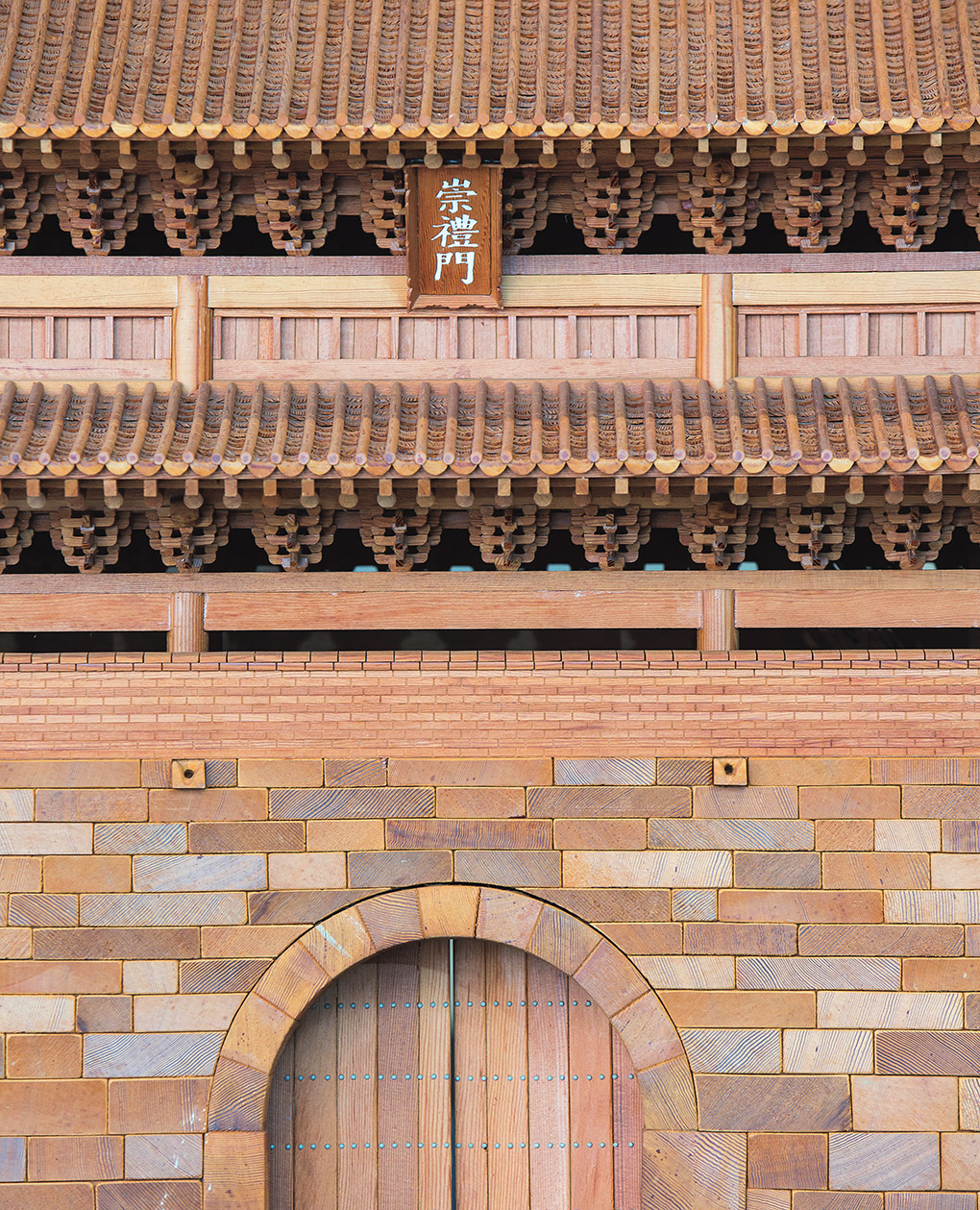
Sungnyemun was the main gate of Hanyang, the capital of the Joseon Dynasty, which largely overlapped with the old city center of Seoul. The two-tiered wooden structure, five bays across and two bays deep, stands on a granite foundation. Built in 1398, the gate was destroyed by fire in 2008 and its restoration was completed in 2013. Kee’s model is recognized as the most faithful replica of the structure before the fire.
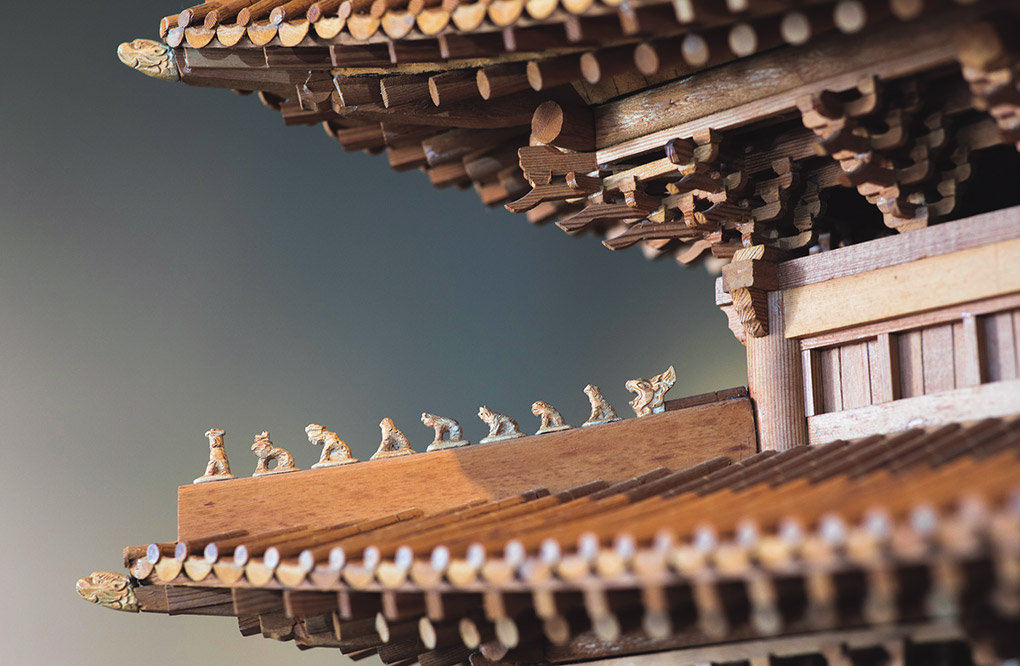
Kee paid the utmost attention to details, including the symbolic figurines on the roof ridges, also scaled down in proportion. In traditional architecture, the animal figurines served both decorative and talismanic purposes.
An Unfulfilled Dream
Models may seem unnecessary in an age when three-dimensional images can be rendered online. But Kee said, “A model is indispensable because it enables an architect to visualize the structure before it’s constructed, and to see how it fits in with the surroundings. To convey the intentions behind the design, the model maker must follow the exact process of constructing the actual structure based on the drawings.”
The same is true for reproducing traditional architecture, which requires a series of arduous procedures: erecting pillars on foundation stones, building the framework with beams and rafters, laying the tiled roof and fitting windows and doors. “A mere copy of the external features will not impress the viewer,” he said. “A model should be both precise and beautiful.”
The hardest part of assembling models of traditional buildings is obtaining good timber. To prevent the wooden parts from cracking, Kee uses fine-quality red pine, the same wood used for actual hanok (traditional Korean houses), and assembles the parts without nails, using the traditional dovetail joinery method to remain faithful to the original aesthetics.
As of now, Kee’s museum dream has not been entirely fulfilled. He plans to open another exhibition hall in the annex behind the main museum to display works currently in storage. And yet another museum is planned to open somewhere near Songdo or Deokjeok Island in Incheon, closer to his hometown in North Korea.
“Building architectural models is a way to help restore our disappearing cultural heritage, and to predict and prepare for problems that may arise in the future. This has been my mission for over 50 years now and will continue to be so until the end of my life,” he said.